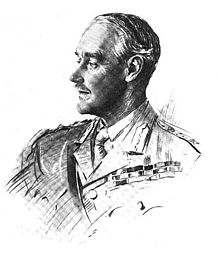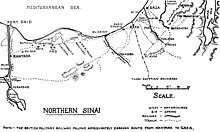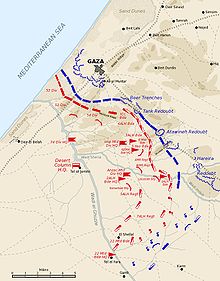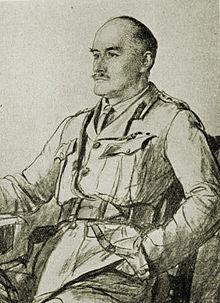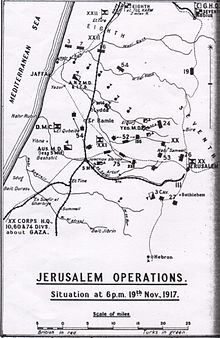Egyptian Expeditionary Force
The Egyptian Expeditionary Force (dt. Egyptian Expeditionary Force ) was a military major unit of the British Empire , of the First World War from 1916 to 1918 in the Sinai and Palestine front was used. He emerged from the Mediterranean Expeditionary Force , which had previously been used in the failed Gallipoli company , and the troops already in Egypt ( Suez Canal Defense and Western Frontier Force ).
Attempts by the Ottoman Army to advance into the Suez Canal were rejected until the summer of 1916. In the subsequent British counter-offensive, Palestine was conquered until the end of the war and important cities in present-day Syria , Jordan and Lebanon were also occupied until the victory in October 1918 .
history
Lineup
In January 1916, British troops in Egypt were placed under the command of General Archibald Murray . Until March 1916, the Canal Defense Force , which had previously defended the Suez Canal , was concentrated in the Port Said section :
- 42nd (East Lancashire) Division
- 52nd (Lowland) Division (Major-General WEB Smith)
- ANZAC Mounted Division (Major-General Sir Henry Chauvel )
- New Zealand Mounted Rifles Brigade (Brigadier-General Edward Chaytor )
- 5th Mounted Brigade (Brigadier-General EA Wiggin)
- Imperial Camel Corps Brigade (Brigadier-General Clement Leslie Smith)
After the failure of the British-French Gallipoli expedition , the British Salonika Force was founded with the embarked troops and the rest of the units were brought to the front on the Sinai Peninsula to reinforce Murray .
On March 10, 1916, the Egyptian Expeditionary Force was set up to protect the Suez Canal, which was threatened by the Ottoman troops , General Murray received the supreme command , General Arthur Lynden-Bell acted as Chief of Staff . By July 1916 Murray had over 240,000 men, including nine infantry divisions, three infantry brigades and nine heavy batteries, several of which went off for the summer offensive in northern France. About 11,000 Indian soldiers were released to reinforce the weak front in Mesopotamia .
The Egyptian Expeditionary Force was initially subject to the following associations:
-
Western Frontier Force (Major-General William Peyton ):
- 53rd (Welsh) Division (Major-General AG Dallas)
- 4th Dismounted Brigade (Brigadier-General EA Herbert)
- 1st - 3rd Battalion of the British West Indies Regiment
- Canal Defenses:
- 52nd (Lowland) Division (Major-General HA Lawrence)
- 1st Dismounted Brigade (General John Stewart-Murray , Marquess of Tullibardine)
- ANZAC Mounted Division (Major General Henry G. Chauvel )
- Eastern Force (IX Corps) (Major General Francis John Davies ):
- 42nd (East Lancashire) Division (Major General W. Douglas)
- 54th (East Anglian) Division (Major General SW Hare)
- 20th Indian Brigade (Brigadier General HD Watson)
- 29th Indian Brigade (Brigadier General PC Palin)
-
Australian and New Zealand Army Corps (Major General Alexander Godley ):
- 4th Australian Division (Major General HV Cox)
- 5th Australian Division (Major General James Whiteside McCay )
- 11th (Northern) Division (Major General Edward A. Fanshawe)
1916
A second attack by the Ottomans on the Suez Canal, which was carried out with the support of the German Asia Corps under General Friedrich Kress von Kressenstein , failed in the Battle of Romani in early August . Immediately afterwards, the British began to gradually recapture the Sinai Peninsula and, as a result of the Battle of Magdhaba (December 28, 1916), were able to take the border fortress town of Al-Arish .
1917
On the newly formed Palestine Front , the Ottoman 8th Army successfully defended the line from Gaza via Tel el Sheria to Beer Sheva . Two British forays into Gaza in March and April 1917 resulted in unsuccessful trench warfare. The first battle for Gaza (March 26-28, 1917) was a failure because Murray's deputy General Charles Macpherson Dobell recalled the cavalry shortly before the decisive breakthrough. In the second battle for Gaza between April 17 and 20, the EEF lost around 6,400 soldiers in the fight against the Ottomans.
On June 28, 1917, General Edmund Allenby was appointed as Murray's successor as the new commander of the Egyptian Expeditionary Force, while Lieutenant General Louis Bols acted as the new chief of staff. In addition, the Desert Mounted Corps had been newly formed, which combined the entire cavalry.
A successful flank attack by the Australian 4th Light Horse Brigade and the British 5th Mounted Brigade led to the capture of Beer Sheva on October 31, 1917 . The loss of this position made the Gaza line no longer tenable for the opposing Army Group Yıldırım . As a result, the Hareira and Sheria posts fell and after the fighting at Tel el Khuweilfe, the British took Gaza in the third battle for Gaza on November 7th . The fighting for Jerusalem began in mid-November 1917. Allenby was able to occupy Jaffa on November 16 and Jerusalem on December 9 .
Division of war in November 1917
-
XX. Corps (Lieutenant-General Sir Philip Chetwode )
- 10th (Irish) Division (Major-General JR Longley)
- 53rd (Welsh) Division (Major-General SF Mott)
- 60th (2 / 2nd London) Division (Major-General Sir JSM Shea)
- 74th (Yeomanry) Division (Major-General ES Girdwood)
-
XXI. Corps (Lieutenant-General Sir Edward Bulfin )
- 52nd (Lowland) Division (Major-General J. Hill)
- 54th (East Anglia) Division (Major-General SW Hare)
- 75th Division (Major-General PC Palin)
-
Desert Mounted Corps (Lieutenant-General Harry Chauvel )
- ANZAC Mounted Division (Major-General Edward Chaytor )
- Australian Mounted Division (Major-General HW Hodgson)
- Yeomanry Mounted Division (Major-General G. de S. Barrow)
- Imperial Camel Corps Brigade (Brigadier-General CL Smith)
1918
On September 19, 1918, the Egyptian Expeditionary Force, concentrated on the coast, attacked the enemy in the decisive battle of Megiddo : The 60th Division deployed on the left wing penetrated several miles deep through the enemy front to the north within a few hours. As a result of the withdrawal of the still intact Ottoman 4th Army (under Mersinli Djemal Pasha), Chaytor's Force was able to cross the Jordan on the eastern battle front and occupy Amman on September 25th .
- XXI. Corps (Lieutenant-General Sir Edward Bulfin ; stretch of coast north of Jaffa)
- 60th (2 / 2nd London) Division (Major-General Sir JSM Shea)
- 5th Light Horse Brigade (Brigadier-General GM MacArthur Onslow)
- 7th (Meerut) Division (Major-General Sir VB Fane)
- 3rd (Lahore) Division (Major-General AR Hoskins)
- 75th Division (Major-General PC Palin)
- 54th (East Anglian) Division (Major-General SW Hare)
- 60th (2 / 2nd London) Division (Major-General Sir JSM Shea)
- Desert Mounted Corps (Lieutenant-General Sir Henry Chauvel)
- Indian 4th Cavalry Division (Major-General Sir George Barrow)
- Indian 5th Cavalry Division (Major-General Henry Macandrew)
-
Australian Mounted Division (Major-General HW Hodgson)
- 3rd Light Horse Brigade (Brigadier-General Lachlan C. Wilson)
- 4th Light Horse Brigade (Brigadier-General William Grant)
- XX. Corps (Lieutenant-General Sir Philip Chetwode)
- 10th (Irish) Division (Major-General JR Longley)
- 53rd (Welsh) Division (Major-General SF Mott)
- Watson's Force (Lieutenant colonel GB Watson)
-
Chaytor's Force (room north of Jericho)
- ANZAC Mounted Division (Major-General Edward Chaytor)
- 1st Light Horse Brigade (Brigadier-General CF Cox)
- 2nd Light Horse Brigade (Brigadier-General G. de L. Ryrie)
- New Zealand Mounted Rifles Brigade (Brigadier-General W. Meldrum)
- 20th Indian Brigade (Brigadier-General ERB Murray)
- ANZAC Mounted Division (Major-General Edward Chaytor)
On October 1, the [[ Arab Revolt]] of Arab cavalry entered Damascus . In the meantime the 3rd (Lahore) Division advanced along the coast towards Beirut , the 7th (Meerut) Division came across Baalbek through the Bekaa Valley . One after the other, Beirut (October 8), Tripoli (October 18) and Aleppo (October 25) fell into the hands of the British without a fight. With the armistice of Mudros the acts of war ended.
literature
- Frederic M. Cutlack: The Australian Flying Corps in the Western and Eastern Theaters of War 1914-1918 (= The Official History of Australia in the War of 1914-1918. Vol. 8). Angus & Robertson, Sydney 1923.
- Edward J. Erickson: Ordered to die. A history of the Ottoman Army in the First World War (= Contributions in Military Studies. 201). Greenwood Press, Westport CT et al. 2001, ISBN 0-313-31516-7 .
- Cyril Falls: History of the Great War: Military Operations, Egypt & Palestine, Volume 2, From June 1917 to the End of the War Part II 1930
- Michael Hickey: The Mediterranean Front 1914-1923 (= The First World War. 4 = Essential Histories. 23). Osprey, Oxford 2002, ISBN 1-84176-373-X .
- Terry Kinloch: Devils on horses. In the words of the Anzacs in the Middle East 1916-19. Exisle, Auckland 2007, ISBN 978-0-908988-94-5 .
- George MacMunn: Military operations Egypt and Palestine. 2 volumes. His Majesty's Stationary Office, London 1928–1930.
- Archibald P. Wavell : The Palestine campaigns. Reprint of the revised edition, 1931. Constable, London 1968.
Web links
- The Palestine campaign 1916–1918 on nzhistory.net.nz (English)
- James E. Kitchen: Egyptian Expeditionary Force , in: 1914-1918-online . International Encyclopedia of the First World War, ed. By Ute Daniel, Peter Gatrell, Oliver Janz, Heather Jones, Jennifer Keene, Alan Kramer, and Bill Nasson, issued by Freie Universität Berlin, Berlin 2017. doi : 10.15463 / ie1418.11098 .
